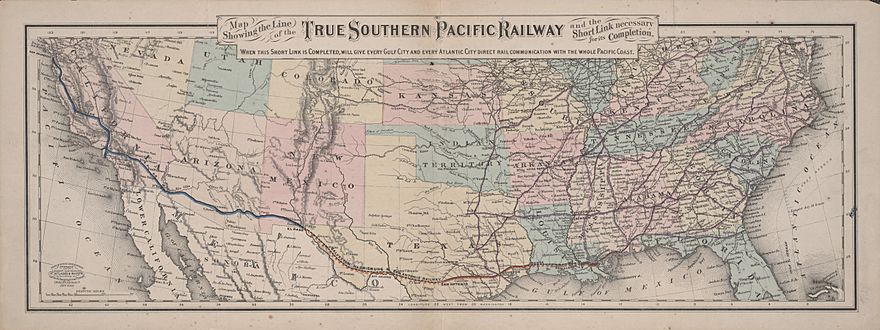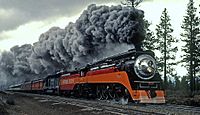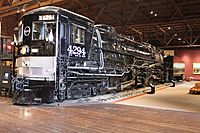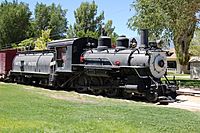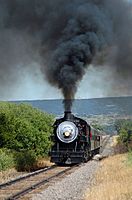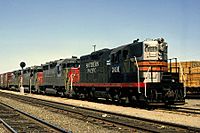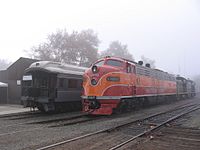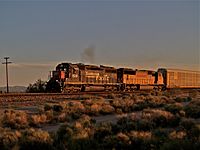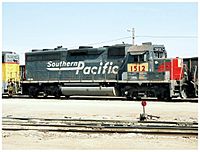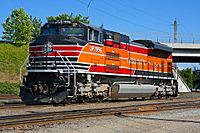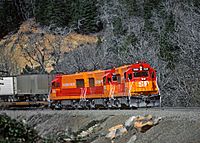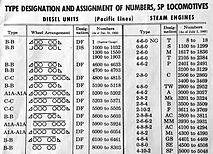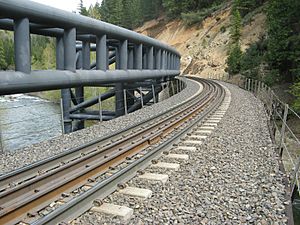Southern Pacific Transportation Company facts for kids
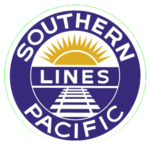 |
|
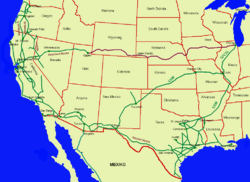
SP system map (before the 1988 DRGW merger)
|
|
| Overview | |
|---|---|
| Headquarters | Los Angeles, California |
| Reporting mark | SP |
| Locale | Arizona, Arkansas, California, Colorado, Illinois, Kansas, Louisiana, Missouri, Nevada, New Mexico, Oklahoma, Oregon, Tennessee, Texas, Utah |
| Dates of operation | 1865–1996 |
| Predecessor | Central Pacific Railroad |
| Successors | Santa Fe Pacific Corporation Union Pacific Railroad |
| Technical | |
| Track gauge | 4 ft 8 1⁄2 in (1,435 mm) standard gauge with some 3 ft (914 mm) narrow gauge branches |
The Southern Pacific (also known as SP or Espee) was a large American railroad company. It operated from 1865 to 1996, mostly in the Western United States. Over the years, it was known by different names, including Southern Pacific Railroad and Southern Pacific Transportation Company.
The original Southern Pacific started in 1865. It was first a company that owned land. The last version of the company, Southern Pacific Transportation Company, began in 1969. It took over all the Southern Pacific train operations. In 1996, the Union Pacific Corporation bought the Southern Pacific Transportation Company. It then became part of the Union Pacific Railroad.
The Southern Pacific company also created hospitals in San Francisco, Tucson, and Houston. In the 1970s, it built a modern telecommunications network. This network later became part of Sprint. The name Sprint came from "Southern Pacific Railroad Internal Networking Telephony."
Contents
The Story of Southern Pacific Railroad
How Southern Pacific Began
The first Southern Pacific Railroad started in 1865. It was a company that owned land. Later, in 1885, it took over the Central Pacific Railroad by leasing it. By 1900, Southern Pacific had become a very important railroad system. It included many smaller companies.
Where Southern Pacific Trains Traveled
The Southern Pacific system stretched far and wide. It went from New Orleans through Texas to El Paso. From there, it crossed New Mexico and went through Tucson to Los Angeles. It covered most of California, including San Francisco and Sacramento.
The Central Pacific lines, which were part of SP, went east across Nevada to Ogden, Utah. They also went north through Oregon to Portland. Other companies that joined Southern Pacific included the St. Louis Southwestern Railway (also called Cotton Belt). It also included the El Paso and Southwestern Railroad and the Northwestern Pacific Railroad. The Southern Pacific Railroad of Mexico was another large part of the system. There were also many smaller, narrow gauge lines.
Important Court Case
In 1886, Southern Pacific Railroad was involved in a famous court case. It was called Santa Clara County v. Southern Pacific Railroad. This case helped set certain rights for companies under the U.S. Constitution.
Changes Over the Years
The Southern Pacific Railroad was later replaced by the Southern Pacific Company. This new company took over the train operations. In 1929, Southern Pacific and its Texas and New Orleans lines ran about 13,848 miles of track. This did not include the Cotton Belt. After the Cotton Belt bought the Golden State Route around 1980, its size almost doubled. This brought the total mileage for SP and Cotton Belt to about 13,508 miles.

In 1969, the Southern Pacific Transportation Company was created. It took over from the Southern Pacific Company. This was the last version of the Southern Pacific railroad. By the 1980s, the total track length had gone down to 10,423 miles. This was mainly because smaller branch lines were removed.
Joining with Rio Grande Industries
On October 13, 1988, Rio Grande Industries took over the Southern Pacific Transportation Company. Rio Grande Industries also owned the Denver and Rio Grande Western Railroad. Instead of merging them, Rio Grande Industries made the Denver and Rio Grande Western Railroad part of Southern Pacific. This allowed the combined system to use the well-known Southern Pacific name. The St. Louis Southwestern Railway, a long-time Southern Pacific company, was also marketed under the Southern Pacific name. With new routes, the total length of the system reached 15,959 miles. Rio Grande Industries later changed its name to Southern Pacific Rail Corporation.
Becoming Part of Union Pacific
By 1996, Southern Pacific had faced many money problems. Its track length had dropped to 13,715 miles. Because of these financial issues, the Union Pacific Corporation took over Southern Pacific Transportation Company. Union Pacific also took over the Southern Pacific Rail Corporation, the Denver and Rio Grande Western Railroad, and the St. Louis Southwestern Railway.
On February 1, 1998, the Union Pacific Railroad merged into the Southern Pacific Transportation Company. The Southern Pacific Transportation Company became the surviving company. At the same time, Union Pacific Corporation renamed the Southern Pacific Transportation Company to Union Pacific Railroad. So, the Southern Pacific Transportation Company is now the Union Pacific Railroad.
Locomotive Colors and Designs
Steam Locomotives: Black, Silver, and Green
Like most railroads, Southern Pacific painted most of its steam locomotives black in the 20th century. After 1945, they started painting the front of the locomotive's smokebox silver. The sides were graphite gray. This was done to make them easier to see.
Some old steam locomotives being fixed up show signs of dark green paint. Books with old photos show that some smaller yard engines were painted in many colors. They had red roofs, silver smokeboxes, and dark green boilers. These special paint jobs lasted for years.
-
Restored No. 1744 when it ran on the Rio Grande Scenic Railroad
The Famous Daylight Scheme
Some passenger steam locomotives had the Daylight paint scheme. This was named after the trains they pulled, many of which had "Daylight" in their name. This design was on the tender (the part that carries fuel and water). It was bright red on the top and bottom. The middle part was bright orange. Thin silver-gray lines separated these colors. Some of these colors continued onto the locomotive itself.
The most famous "Daylight" locomotives were the GS-4 steam locomotives. The most well-known trains with this look were the Coast Daylight and the Sunset Limited.
Unique Cab-Forward Locomotives
Southern Pacific was also known for its special "cab-forward" steam locomotives. These engines were built to run backward. The tender was attached to the smokebox end. Southern Pacific had many snow sheds in the mountains. Train crews sometimes had trouble breathing from smoke inside the cab. To solve this, Southern Pacific asked Baldwin Locomotive Works to build these cab-forward designs. No other railroad in North America ordered locomotives like these.
Diesel Locomotives: From Black to Bloody Nose
Early diesel locomotives were also painted black. Yard switchers had orange stripes on their ends. This was for better visibility and was called Tiger Stripe. Freight trains were black with a red band at the bottom. They had a silver and orange "winged" design on the front. The words "SOUTHERN PACIFIC" were in a light gray color. Fans called this the Black Widow scheme.
An experimental design was all black with orange details. This was known as the Halloween scheme. More than 200 locomotives were painted this way between 1957 and 1958.
Most passenger diesel trains first used the Daylight scheme. Some were painted red on top and silver below for the Golden State train. Silver cars with a thin red band were used for the Sunset Limited and other trains. In 1958, Southern Pacific started using a standard dark gray color. It had a red "winged" nose. Fans called this the Bloody Nose scheme. The lettering was still light gray.
The Kodachrome Scheme
In the mid-1980s, many Southern Pacific locomotives got the "Kodachrome" paint scheme. This was because of a planned merger with the Santa Fe railroad. The colors were like those on Kodak film boxes. When the merger did not happen, these locomotives were not immediately repainted. Some even kept the Kodachrome colors until Southern Pacific stopped being an independent company.
Special Features of SP Diesels
Southern Pacific diesel trains often had many lights on the front and back. They had a large red Mars Light for emergencies. They also had two pairs of headlights. One pair was on top of the cab, and the other was below the Mars Light. Starting in the 1970s, new locomotives had air conditioning on the cab roof.
Southern Pacific also put large snowplows on their trains. This was for heavy snow on Donner Pass. Many of their trains had a special air horn sound. This sound was unique to Southern Pacific locomotives in the western states.
Tunnel Motors and L-Shaped Windows
Southern Pacific and Cotton Belt were the only companies to buy the EMD SD45T-2 "Tunnel Motor" locomotive. These trains were special because they could get enough cool air in tunnels and snow sheds. Regular locomotives would overheat in these places. The "Tunnel Motors" had air intakes lower down on the train body. This helped them avoid hot exhaust fumes that gathered at the top of tunnels. Southern Pacific also used EMD SD40T-2s, just like the Denver and Rio Grande Western Railroad.
Southern Pacific was known for its L-shaped engineer's windshields. This design improved visibility by removing the middle bar in the window. Southern Pacific chose this design for new locomotives starting in 1967. They were one of the few railroads to do so.
Train Numbers on Locomotives
Unlike other railroads, Southern Pacific used the number boards on its locomotives for the train number until 1967. For example, trains going towards San Francisco were called 'westward' and had odd numbers. Trains going away from San Francisco were 'eastward' and had even numbers.
If a train was too long for one section, it would run in "sections." The first section would have a '1' before the train number. The second section would have a '2', and so on. The last section would just have the train number. Special trains, or 'extras,' had an 'X' before the locomotive number.
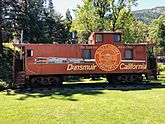
Today, some Southern Pacific locomotives are still used by Union Pacific Railroad. Many have been repainted or had Union Pacific logos added. In 2006, Union Pacific unveiled UP 1996, a special locomotive with colors based on the Southern Pacific's Daylight and Black Widow schemes.
Passenger Train Services
Until May 1, 1971, when Amtrak took over long-distance passenger trains, Southern Pacific ran many famous trains. Some of these trains still run today under Amtrak.
- 49er
- Acadian
- Apache
- Argonaut
- Arizona Limited
- Beaver
- Californian
- Cascade
- City of San Francisco
- Coast Daylight
- Coast Mail
- Coaster
- Del Monte
- Fast Mail
- Golden Rocket
- Golden State
- Grand Canyon
- Hustler
- Imperial
- Klamath
- Lark
- Oregonian
- Overland
- Owl
- Pacific Limited
- Peninsula Commute
- Loop Service
- Rogue River
- Sacramento Daylight
- San Francisco Challenger
- San Joaquin Daylight
- Senator
- Shasta Daylight
- Shasta Express
- Shasta Limited
- Shasta Limited De Luxe
- Starlight
- Sunbeam
- Sunset Limited
- Suntan Special
- Tehachapi
- West Coast
- El Costeño
- El Yaqui
Locomotives Used for Passenger Service
Steam Locomotives
- 2-8-0 Consolidation
- 2-8-2 Mikado
- 4-4-2 Atlantic
- 4-6-2 Pacific – see SP 2472
- 4-8-2 Mountain – see SP Mt-5
- 4-8-4 Golden State/General Service – see SP 4449
- 2-8-8-4
- 4-8-8-2 Cab Forward Articulated
- 4-10-2 Southern Pacific - see SP 5021
Diesel Locomotives
- ALCO PA
- EMC E2
- EMD E7
- EMD E8
- EMD E9
- EMD FP7
- GE 70-ton switcher
- GE U25B
- FM H-12-44
- FM H-24-66 "Train Master"
- EMD GP7
- EMD GP9
- EMD SD7
- EMD SD9
- GE P30CH
- EMD SD40-2
- EMD SDP45
- EMD GP40P-2
- GE AC4400CW
- GE C44-9W
- EMD SD45
- EMD SD45T-2
- EMD SD40T-2
- EMD SD70M
Notable Accidents and Incidents
- On March 28, 1907, the Southern Pacific Sunset Express crashed near Colton, California. It was going too fast and hit an open switch. This caused 24 deaths. Many of the cars were destroyed.
- In the early morning of June 1, 1907, someone tried to derail a Southern Pacific train near Santa Clara, California. They put railway ties on the tracks. A work crew found them and stopped the train.
- On August 12, 1939, the westbound City of San Francisco derailed from a bridge in Palisade Canyon, Nevada. 24 people died, and many were hurt. Five cars were destroyed. It was believed to be an act of sabotage, but no one was ever caught.
- On New Year's Eve 1944, a train crash west of Ogden in thick fog killed 48 people.
- On January 17, 1947, the Southern Pacific Nightflier crashed near Bakersfield. Seven people died, and over 50 were injured. Four coaches overturned.
- On May 8, 1948, in Monterey, California, a Southern Pacific passenger train hit a car. The car was driven by marine biologist Ed Ricketts.
- On April 28, 1973, a Southern Pacific freight train carrying munitions exploded in Roseville Yard. 52 people were injured. The explosion happened because a hot part on a railcar caused a fire.
- On the night of July 14, 1991, a Southern Pacific train crashed into the upper Sacramento River. This happened at a sharp curve called “the Cantara Loop” near Dunsmuir, California. A tank car broke open and spilled about 19,000 gallons of metam sodium. This is a chemical used to treat soil. Over a million fish and many other animals died. Millions of tiny water creatures were also destroyed. Hundreds of thousands of trees died or were badly hurt.
The chemical spread for 41 miles down the river to Shasta Lake. This accident is still the largest hazardous chemical spill in California's history. At the time, metam sodium was not even considered a dangerous material.
Preserved Locomotives
Many Southern Pacific locomotives are still used today by railroads like the Union Pacific Railroad. Many older and special locomotives have been given to parks and museums. Some still run on scenic or tourist railroads. Most of the engines now with Union Pacific have been "patched." This means the SP logo is replaced with a Union Pacific shield, and new numbers are put over the old ones. However, some engines still have their original Southern Pacific "bloody nose" paint. As of January 2019, fewer than ten units still have their old paint.
Some notable preserved locomotives include:
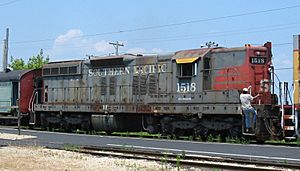
- 745 (Mk-5, 2-8-2), owned by the Louisiana Rail Heritage Trust.
- 786 (Mk-5, 2-8-2), owned by the City of Austin. It is being fixed up in Austin, Texas.
- 794 (Mk-5, 2-8-2), the last Mikado built for the Texas and New Orleans Railroad. It is on display in San Antonio, Texas.
- 982 (F-1, 2-10-2), its tender is in Heber City, Utah. The main part is in Houston, Texas.
- 1518 (EMD SD7), the first SD7 ever built. It is at the Illinois Railway Museum, Union, Illinois.
- 1744 (M-6, 2-6-0), parts are being gathered to fix it up for the Niles Canyon Railway.
- 2248 Puffy (T-1, 4-6-0), used by the Grapevine Vintage Railroad. It needs a major check-up.
- 2467 (P-8, 4-6-2), on loan to the California State Railroad Museum.
- 2472 (P-8, 4-6-2), owned and operated by the Golden Gate Railroad Museum.
- 2479 (P-10, 4-6-2), being fixed up by the California Trolley and Railroad Corporation.
- SP 3100 (U25B), owned and operated by the Orange Empire Railway Museum, Perris, CA.
- 3420 (C-19, 2-8-0), stored in El Paso, Texas.
- 3769 (EMD GP9), on display and used as a switch engine at the Utah State Railroad Museum in Ogden, Utah.
- 4294 (AC-12, 4-8-8-2), located at the California State Railroad Museum, Sacramento, California.
- 4449 (GS-4, 4-8-4), located at the Oregon Rail Heritage Center in Portland, Oregon.
- 4460 (GS-6, 4-8-4), located at the National Museum of Transportation, Kirkwood, Missouri.
- 7457 (EMD SD45), the first SD45 diesel-electric switcher built for Southern Pacific. It is at the Utah State Railroad Museum.
For a full list, see: List of preserved Southern Pacific Railroad rolling stock.
Company Leaders
Presidents of Southern Pacific
- Timothy Guy Phelps (1865–1868)
- Charles Crocker (1868–1885)
- Leland Stanford (1885–1890)
- Collis P. Huntington (1890–1900)
- Charles Melville Hays (1900–1901)
- E. H. Harriman (1901–1909)
- Robert S. Lovett (1909–1911)
- William Sproule (1911–1918)
- Julius Kruttschnitt (1918–1920)
- William Sproule (1920–1928)
- Paul Shoup (1929–1932)
- Angus Daniel McDonald (1932–1941)
- Armand Mercier (1941–1951)
- Donald J. Russell (1952–1964)
- Benjamin F. Biaggini (1964–1976)
- Denman McNear (1976–1979)
- Alan Furth (1979–1982)
- Robert Krebs (1982–1988)
- D. M. "Mike" Mohan (1988–1993)
- Edward L. Moyers (1993–1995)
- Jerry R. Davis (1995–1996)
Chairmen of Executive Committee
- Leland Stanford (1890–1893)
- (vacant 1893–1909)
- Robert S. Lovett (1909–1913)
- Julius Kruttschnitt (1913–1925)
- Henry deForest (1925–1928)
- Hale Holden (1928–1932)
Chairmen of Board of Directors
- Henry deForest (1929–1932)
- Hale Holden (1932–1939)
- (position nonexistent 1939–1964)
- Donald J. Russell (1964–1972)
- Benjamin F. Biaggini (1976–1982)
- Denman K. McNear (1982–1988)
- Edward L. Moyers (1993–1995) Chairman/C.E.O.
Notable Employees
- Carl Ingold Jacobson, a Los Angeles City Council member.
- W. Burch Lee, worked in the New Orleans office before serving in the Louisiana House of Representatives.
- Blake R. Van Leer, a U.S. Army Officer and inventor, who later became President of Georgia Tech.
- Charles Wright, a land surveyor for the railway who later became a botanist.
- Jack Kerouac, a famous novelist.
- Jimmie Rodgers (country singer), known as the Father of Country Music.
See also
 In Spanish: Southern Pacific para niños
In Spanish: Southern Pacific para niños


